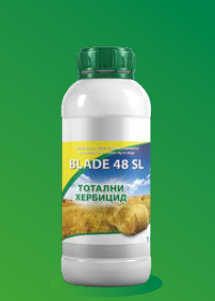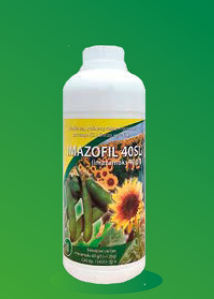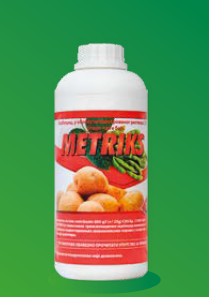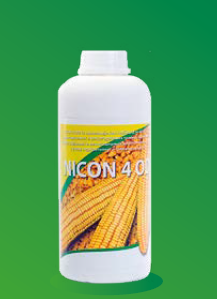Blade 48 SL
Volume:
1 l
BLADE 480 SL is a non-selective (total) systemic herbicide for controlling perennial rhizome weeds, as well as annual and perennial narrow-leaved and broad-leaved weeds on non-agricultural and agricultural areas.It is applied exclusively to sprouted weeds that adopt it with their green parts.Active substance: glyphosate.....................480 g/lFormulation: concentrated solution (SL)Application:1) in orchards and vineyards, by treating when the weeds are 15-40 cm high, in the dose: a) 2-4 l/ha, for controlling annual weeds b) 4-8 l/ha, for controlling perennial weeds c) 8-12 l/ha, for controlling extremely resistant perennial weeds2) on stubbles, in a dose of 3-10 l/ha, for the suppression of annual and perennial narrow-leaved and broad-leaved weeds, by treatment depending on the weeds present, in the phase of intensive growth until the phase of full flowering.3) for suppression of shoots and stumps, by treatment immediately after cutting the tree, in conc. 10% in the period May-December.4) before preparing the soil for sowing or planting agricultural crops in a dose of 2-6 l/ha, depending on the type and stage of weed development5) on meadows and pastures by treating when weeds are in the phase of intensive growth, at a dose of 2-8 l/ha, depending on the type and stage of weed development6) for desiccation of oilseed rape, in a dose of 2-4 l/ha, treated 14 days before harvest7) in dry canals or occasionally flooded canals and swamps, which are brought to culture afterdrainage in a dose of 4-8 l/ha8) in forestry, in a dose of 4-12 l/ha depending on the type of plantings and weeds to be controlled9) on non-agricultural areas, as a total herbicide, in a dose of 3-12 l/ha, by treating when the weeds are in the phase of intensive growth until the full flowering phase.10) on homesteads, the area around industrial buildings, power lines, cemeteries, etc., using backpack sprinklers, in concentration:- 1% (100 ml in 10 l of water), for controlling annual weeds- 2% (200 ml in 10 l of water), for controlling perennial weeds.The dosage of the preparation depends on the type of weed being treated and the degree of weediness.• 4 l/ha for the control of sedges, magpies, sedges, sedges, ragweeds, sedges, sedges, styra, field sedge, micelles, violets, thistles, thistles,• 4-6 l/ha to control wild sorghum from rhizomes, bonito, mint, tansy, dandelion,...• 6-8 l/ha for control of blackberry, blackberry, and wild blackberry• 8-12 l/ha for control of horsetails (horsetails)Waiting period:• fruit and vines – 35 days,• pre-harvest application in small grains and oilseed rape – 14 daysToxicity: III group of poisonsPackaging: 5, 1, and 0.25 litersBefore applying the preparation, be sure to read the instructions for use!
Imazofil 40 SL
Volume:
1 l
Selective systemic herbicide for controlling broadleaf weeds in soybean, pea, bean, alfalfa and sunflower crops.Active substance: imazamox.......... 40 g/lFormulation: concentrated solution (SL)Mode of action: Post-emergence herbicide that is absorbed by the leaves and roots and translocated to the growing parts. It inhibits the synthesis of essential amino acids by inhibiting the enzymes acetolactate synthetase (ALS, AHAS) that catalyze their synthesis.The selectivity in relation to soy is based on rapid detoxification through demethylation and glucosylation processes.Application:- In the crop of soybeans, peas, beans after crop emergence when the crop is in the 1-3 trefoil phase (phases 11-13 of the BBCH scale) in a dose of 1-1.2 l/ha-In the alfalfa crop in the establishment after crop emergence, in the stage of the third trefoil (stage 13 of the BBCH scale) in a dose of 1-1.2 l/ha-In the sunflower crop (only tolerant to imidazolinones) from emergence up to three pairs of leaves (stages 05-15 BBCH scale) in a dose of 1.2 l/ha or in split application 0.8 l/ha (in the stage up to the third pair of leaves sunflower), second application 0.4 l/ha (after 7-10 days).Water consumption: 200-400 l/haSpectrum of activity: Annual and some perennial broad-leaved and some narrow-leaved weedsWeed species that it controls well in a dose of 1 l/ha:-Broad-leaved weeds: Amaranthus blitoides, A. retroflexus, Bilderdyckia convolvulus, Chenopodium album, Datura stramonium, Polygonum persicaria, Field mustard ( Sinapis arvensis), common aide (Solanum nigrum), common bottle (Xanthium strumarium).- Side-leaf weeds: gray fly (Setaria glauca), green fly (Setaria viridis), sticky fly (Setaria verticillata), wild sorghum from seed (Sorghum halepense).Weed species that it controls well in a dose of 1.2 l/ha:-Broad-leaved weeds: diaper ragweed (Ambrosia artemisiifolia), lipica (Abutilon theophrasti)Weed species that are weakly controlled by both doses of application:-Broad-leaved weeds: watermelon (Hibiscus trionum)Mixing with other preparations: must not be mixed with insecticides from the group of carbamates and organophosphatesMaximum number of treatments on the same surface during the year: onceWithdrawal period: soybean - 35 days, sunflower - provided by the time of applicationCrop rotation:- 4 months after application of the preparation on the treated surfaces, the following can be sown: barley, wheat, rye, sunflower and tobacco- 9 months after the application of the preparation, untreated areas can be sown: corn, cotton, potatoes and rice- 12 months after the application of the preparation on the treated surfaces, the following can be sown: oilseed rape and sugar beet.Packaging: 1 liter
METRIKS
Selective systemic herbicide for the control of broadleaf weedsin soybean, pea, bean, alfalfa and sunflower crops.Active substance: metribuzin.......... 600 g/lFormulation: concentrated suspension (SC)Mode of action:Metribuzin is absorbed by the roots and transported to the xylemaerial parts of plants. Absorption and translocation increasewith increased transpiration. Medium is absorbed afterwardsfoliar applications and is transported acropetally. It is a process inhibitorphotosynthesis. Susceptible seedlings treated over the soil becomechlorotic and complete necrosis occurs in 2-5 days in the suntime.Application:- In the soybean crop by treating the soil after sowing and before sproutingcrops in the amount of 0.35 l/ha on soils with 1.5-3% humus; inamount of 0.55 l/ha on soils with more than 3% humus.In relation to weeds, it is applied before weed emergence or from the stagecotyledons up to a maximum of 4 developed leaves.- In the potato crop by treating the soil after planting and beforepotato sprouting in the amount of 0.75 l/ha on soils with 1.5-3%hummus; in the amount of 1.25 l/ha on soils with more than 3% humus.It can also be applied after the sprouting of potatoes and weeds when they arepotatoes 5-10 cm high (5-8 developed potato leaves, stages of development15-18 BBCH) in the amount of 0.5 l/ha on soils with 1.5-3% humusand 0.75 l/ha on soils with more than 3% humus.Water consumption: 200-400 l/haSpectrum of action: Annual broadleaf weeds.Weed species that it controls well: Theophrastus linden (Abutilon theophrasti), styrus (Amaranthussp.), common loboda (Atriplex patula), black rapeseed (Brassica nigra), ash (Chenopodium sp.),common datula (Datura stramonium), common sedge (Galinsoga parviflora), gardenia (Polygonum sp.),horseradish (Portulaca oleracea), wild radish (Raphanus raphanistrum), field mustard (Sinapisarvensis), one-year-old sedge (Stachys annua), sedge (Stellaria media).Weed species that are satisfactorily controlled: ragwort (Ambrosia artemisiifolia),Capsella bursa pastoris, field watermelon (Hibiscus trionum), dead nettlered (Lamium purpureum), wild lettuce (Lactuca seriola), nightshade (Veronica persica).Weed species that it controls poorly: common sedum (Solanum nigrum), bottles (Xanthium sp.).Mixing with other preparations: It is mixed with herbicides based on S-metolachlor, pendimethalin,dimethenamid, flurochloridone. When applied in potatoes after crop emergence, do not mixwith other herbicides.Maximum number of treatments on the same surface during the year: once.Withdrawal period: soy, alfalfa - provided by the time of application; 42 days – potatoes, tomatoes.Crop rotation:• 4 months after application of the preparation on the treated surfaces, the following can be sown: potatoes, soybeans, alfalfa,peas, lentils, asparagus, tomatoes, forage grasses, wheat, barley, corn• 12 months after application of the product on the treated surfaces, the following can be sown: cabbage, lettuce,cucumber, melon, sugar beet, onion.• 18 months after application of the product on the treated surfaces, the following can be sown: other root and tuber plantsvegetables.Packaging: 1 liter
Nicon 4 OD
Volume:
1 l
Selective systemic herbicide used for controlannual and perennial grasses, as well as annualsand perennial broadleaf weeds in the mercantile isilage cornActive substance: nicosulfuron.......... 40 g/lFormulation: oil dispersion (OD)Mode of action:- Belongs to the sulfonylurea group- It is absorbed through leaves and roots, moves up and down in the plant,it moves rapidly into the meristem tissues- It inhibits the synthesis of acetolactate synthetase (ALS), thus preventing itsynthesis of branched amino acids.Application:It is used in mercantile and silage corn crops:1) One-time application, when the crop has 2-6 leavesa) 1 l/ha (10 ml per 100 m²), for the suppression of annual grasses andbroadleaf weeds, by treating when the weeds are in the 2-6 leaf stage.b) 1.25 l/ha (12.5 ml per 100 m²), to control wild sorghum from the rhizome,treatment when the weed is 15-20 cm high.2) Double application (split application):a) first treatment in the amount of 0.75 l/ha (7.5 ml per 100 m²), whenannual grass weeds and annual and perennial broadleaf weedsweeds in the 2-4 leaf stage and wild sorghum just sprouted;b) second treatment in the amount of 0.5 l/ha (5 ml per 100 m²), whenannual grass and annual and perennial broadleaf weedsregenerated, and wild sorghum 15-20 cm high.Spectrum of action: Grassy and broad-leaved weedsWeed species it controls well:- annual grass (scoly-leaved) weeds, such as: weed millet (Echinochloa crus-galli), flyleafgray (Setaria glauca), wild sorghum from seeds (Sorghum halepense).- perennial grass (scolyte) weeds, such as wild rhizome sorghum (Sorghum halepense)- one-year broad-leaved weeds, such as: Theophrastus linden (Abutilon teophrasti), Styr ordinary(Amaranthus retroflexus), common loboda (Atriplex patula), common ash (Chenopodium album),Datura stramonium, Hibiscus trionum, Papaverrhoeas), common bitter gourd (Polygonum lapathifolium), field mustard (Sinapis arvensis), bottle gourd(Xanthium strumarium),..- perennial broad-leaved weeds, such as: Bonamida Njiva (Cirsium arvense), Poponac Njiva(Convolvulus arvensis).Mixing with other preparations:It can be mixed with preparations based on dicamba and 2,4-D (Dicopur Top), 2,4-D and fluorasul (Mustang), mesotrione (ESMERO)Maximum number of treatments on the same surface during the year: once or twice (in doubleapplication)Withdrawal period: provided by the time of applicationToxicity: III group of poisonsPackaging: 1 liter, 0.5, 0.25 and 0.1 liters





